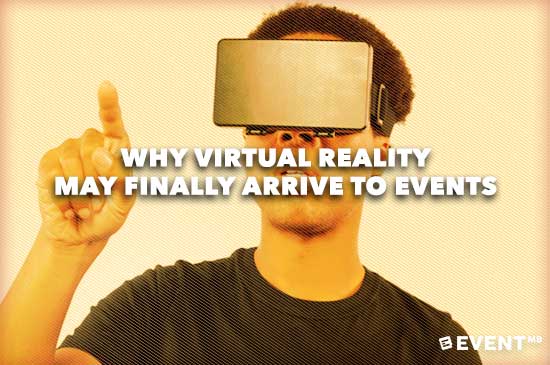Virtual reality has been a topic of discussion in the event industry for a while. With the popularity of the Second Life platform years ago, a few technology developers ventured into the virtual event space with products based on similar principles, but most failed to achieve widespread adoption. Today, the talk is different and VR seems to be on just about everyone’s predictions list.
What is VR?
Virtual reality is the term given to a computer-generated “environment” that allows the participant to move and interact with images in the way that simulates the physical world. It involves hardware – goggles, helmets, gloves, for example – that help trick the brain into believing that its owner is actually on the moon or flying through space.
A virtual reality experience is intended to be immersive. In other words, really effective VR technology can place the user in an alternative state where he or she is able to experience situations or absorb information in a way that is either too difficult or physically impossible to experience in a non-VR environment. This kind of suspension of disbelief can therefore be quite useful in certain circumstances.
How does VR Work?
To create a virtual landscape requires three components: a computer (PC, game console or smartphone) to operate the application, a headset or display to put in front of the user’s eyes, and devices (controllers, microphones, trackpads) to deliver input or instructions from the user’s body to the app.
Video is sent from the computer to either one or two displays (one per eye) in the headset. Lenses inside the Goggles refocus and reshape the images to make them appear three-dimensional. More reality is added as the app plots the movements of the user’s head, hands, or voice into the virtual landscape.
Augmented Reality vs. Virtual Reality
Many of the instances of computer wizardry already seen inside and outside the event industry are actually examples of augmented reality – 3-D graphics that appear as layers on top of objects in the real world. Virtual reality immerses users in 360-degree views of entirely new worlds that users can interact with and often manipulate.
Why now?
There are a couple of reasons why virtual reality could actually penetrate the eventosphere starting in 2016:
Facebook, Sony, Samsung, and Google are involved. And while they aren’t big players in the event space, their participation will validate the technology and bring the cost of devices down.
Experience, the hallmark of virtual reality, has become a fundamental building block (and buzzword) of events. Organizers will be consistently challenged to deliver new and exciting experiences like VR to keep events fresh.
Attendees are getting younger. It will be more difficult in the years ahead to capture the attention of young, video-game-playing, smartphone-clutching buyers with square stands, boring lectures, and staid cocktail parties. Event organizers will have to take a look at virtual reality to maintain their customer bases.
Low-hanging fruit
It doesn’t seem feasible (or safe) to imagine attendees walking through an event wearing VR headsets, but there are a couple of event use cases that are viable now:
Sponsors and sponsorships are evolving. While many companies enjoy the simplicity of graphics and signage, others are keen to take advantage of opportunities to interact with event attendees in new and different ways.
Many events deliver education and training for certifications. Virtual reality (simulations, for example) is known to be highly effective for helping individuals to learn and remember new skills.
Product demonstrations are a mainstay at trade shows. It’s conceivable that some exhibitors would prefer the impact of an immersive, VR-type product demonstration rather than a person on a stage or a video. One can easily imagine booth visitors with VR headsets on being allowed to “try” a product or piece of equipment too large to fit inside a booth.
Virtual reality is a perfect fit for games. For whatever reason an organizer would employ a mobile game app, it may also consider a virtual reality experience as a way to make the game appear even more real.
Keynote addresses. A number of technologies from holograms to Telepresence have been making headway in the event space as alternatives for live keynote speakers. One interesting twist could be substituting a VR experience for a live speaker.
In Conclusion
Virtual reality – the much discussed and often discounted technology – is finally arriving to mass consumers and VR developers have been thinking about how to move it beyond entertainment into other fields. The good news for event organizers is that the costs for viewing and creating content is dropping at the same time that use cases are coming into view. If the industry is truly serious about fomenting experiences in the event space, virtual reality is a splendid option.





